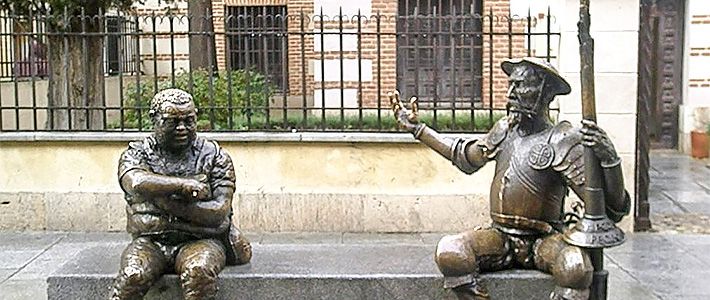
Translating the Impossible Dream: "Don Quixote" and Japan
Culture- English
- 日本語
- 简体字
- 繁體字
- Français
- Español
- العربية
- Русский
This year marks the four-hundredth anniversary of the death of Miguel de Cervantes, author of Don Quixote, in April 1616. Originally published as El ingenioso hidalgo Don Quixote de la Mancha (The Ingenious Gentleman Don Quixote of La Mancha), this novel is the most universally acclaimed work in the Spanish literary canon, and the anniversary of the author’s death is the occasion for renewed tributes.
Don Quixote was first published in Japanese in the late nineteenth century, and since then the masterpiece has been retranslated numerous times. Many of the translations are rigorously academic tomes brimming with scholarly annotations. But some translators have managed to convey the jocular tone of the original while tapping distinctive features of the Japanese language in a way that would surely have pleased Cervantes.
The Knight of the Sorrowful Countenance
Don Quixote is widely recognized throughout Japan. Children can read condensed and illustrated editions of the story, and there is at least one manga version available online. Not only that, but Don Quijote, the name of the hero in modern Spanish, has become a household word as the name of a popular discount franchise.
Japanese dance companies have staged successful performances of the ballet Don Quixote, with theatrical versions of the tale also drawing crowds. Actor Nakadai Tatsuya, who played the lead roles in Ran, Kagemusha, and other classic films by director Kurosawa Akira, has taken the stage in the Spanish nobleman’s robes hundreds of times during his illustrious career. And the renowned kabuki actor Matsumoto Kōshirō has appeared as the aged knight in the musical Man of La Mancha more than 1,200 times, enchanting audiences with a Japanese rendition of “The Impossible Dream.”
 The popular franchise Don Quijote in Shinjuku, Tokyo.
The popular franchise Don Quijote in Shinjuku, Tokyo.
A Plethora of Translations
The first volume of Don Quixote, considered to be the earliest modern novel written in the West, was published in 1605, with an English edition appearing seven years later. Renderings into other European languages followed, and today the story is one of the most translated works of fiction in history.
It took the better part of two centuries for this magnum opus to make its way to Japan, however. Hasekura Tsunenaga may well have heard of the popular novel when he traveled to Europe as head of the Keichō Embassy, an early-seventeenth-century diplomatic mission to Spain and the Vatican. As Hasekura and his companions made their way to Madrid for an audience with King Philip III, they passed through the valley of La Mancha, the arid but fertile setting for the fictional adventures of Don Quixote and his squire Sancho Panza. Cervantes’s book, however, was not among the curiosities Hasekura brought back to Japan when he returned in 1620. It was not until 1893 that the first Japanese edition appeared, translated by playwright Matsui Shōyō from an abridged version in English. Since then the story has been rendered into Japanese nine more times, including translations of partial editions and of non-Spanish versions, along with revisions of earlier works. Four new translations have been published in just the past three decades, and yet another now awaits publication.
Varying Interpretations
In the tale, Don Quixote points out the pitfalls of rendering literature into another language by famously comparing reading a translated novel to observing a Flemish tapestry from the wrong side: “Though the figures are visible, they are full of threads that make them indistinct.” This description could well be applied to some of the Japanese versions of Cervantes’s work.
According to Yoshida Saiko, a professor of Spanish language and literature at Seisen University, some Japanese translators of Don Quixote have ben so eager to convey every minute detail of the story that they have supplemented the text with their personal interpretations, making the lengthy work even longer. But the translation process has been felicitous in some respects. Professor Yoshida, who also teaches literary analysis of the novel, points out how aspects of Japanese, such as using the pronoun washi (I) to convey that an elderly man is speaking, contribute elements not found in the original. In addition, Japanese translators often have Sancho Panza speak in dialect to highlight his provincial origins. In some versions the squire speaks in a vernacular formed from a mixture of Japanese country parlance, which has the effect of inviting readers’ minds to wander with Don Quixote through an imaginary region of Japan.
A quick online search reveals the most expensive Japanese edition of Don Quixote to be one translated by Ogiuchi Katsuyuki and illustrated by the painter Horikoshi Chiaki. Ogiuchi’s translation, which was published in four volumes by Shinchosha in 2005, is also considered one of the most humorous and accessible for Japanese audiences and is the edition that inspired Nakadai to take on the role of Don Quixote.
A Story Full of Treasures
The wide selection of Japanese translations is testimony to the timeless worth of Cervantes’s tale, which illustrates how little we humans have changed over the last 400 years in our behavior, whether in love, religion, war, or politics. Love in the pages of Don Quixote is blind, passionate, impossible, comic, and unrequited. And we find a wealth of quotes apt to today’s world in the lines of great common sense spoken by diverse characters— noblemen, peasants, wise men, knights, Catholics, Muslims, Jews.
The story also features criminals, battles, travels to foreign countries and lands of fantasy, a robot-like wooden horse, and a live lion. And at a formal level, Don Quixote is a catalogue of technical innovations that are still in use in narrative forms like film, theatre, television, and video games, as well as in literature.
Professor Yoshida acknowledges it is difficult to expect the Twitter generation to embrace a novel several hundred pages long, but she is reluctant to make the classic more accessible to her students by only recommending certain passages or chapters. She instead suggests they read a paragraph from Don Quixote whenever they can, holding firmly to the belief that they will discover something that strikes a chord. On the four-hundredth anniversary of the death of Cervantes, we have every reason to open the book and allow it to surprise us all over again.
(Originally written in Spanish and published on April 5, 2016. Banner photo: Bronze statues of Don Quixote and Sancho Panza in Alcala de Henares, Madrid.)